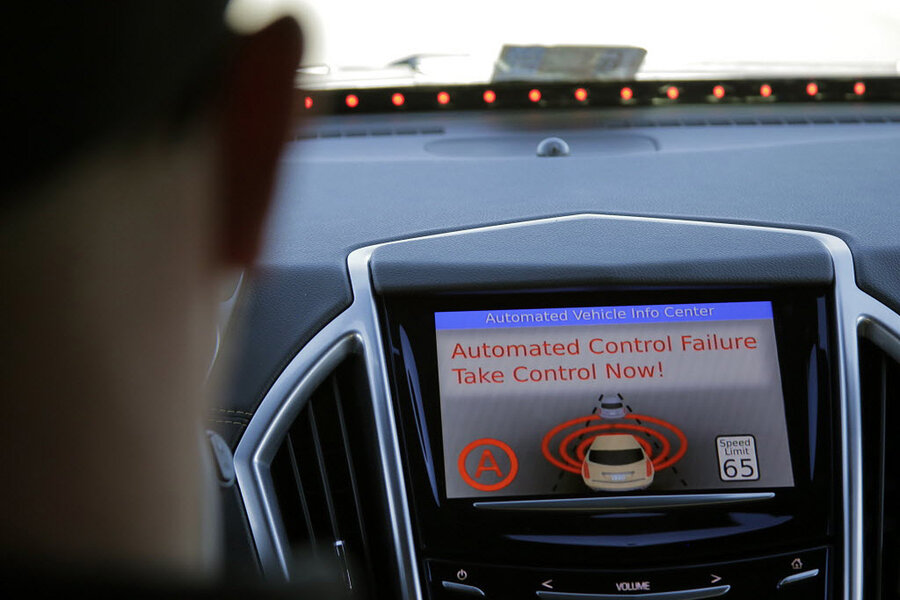Why self-driving cars are still being driven by humans
Loading...
Self-driving cars, heralded as the wave of the future by carmakers and technology companies, are making progress, with seven companies currently testing the cars on public roads in a range of road conditions in California.
But along the way, the cars have often needed human drivers to take over due to brief technology failures or safety concerns, indicating the technology may still have a ways to go, according to reports the companies filed with the California Department of Motor Vehicles on Tuesday.
The reports show the companies’ results vary widely, with electric carmaker Tesla reporting no incidents, while Nissan had 106 despite having driven a relatively small 1,485 miles since November 2014.
Google — which has far outstripped other companies in the number of miles its cars have driven and has been aggressive in pushing the DMV to release its regulations for the cars — had a mostly positive safety record.
A human driver had to take over Google’s self-driving car 341 times since the company was granted a permit to begin testing it by the DMV in September 2014, a relatively impressive record considering its self-driving cars have driven more than 1.3 million miles, 424,331 of which were on public roads in California.
A relatively slim 69 of those incidents were due to a human driver needing to take control of the vehicle because of safety concerns. But in 13 of the cases, the company’s simulation found, the self-driving car would have had a collision with an object (including other cars and traffic cones) if the driver had not taken over.
Previously, the head of the company’s self-driving car project said one challenge was overcoming the car’s tendency to be extra-cautious in order to avoid accidents. Since September 2014, the cars have been involved in nine accidents, though in each case another driver was found to be at fault, according to researchers from the University of Michigan.
“Our cars today, we think, do a really good job avoiding accidents. They do that by being a little oversensitive to the signals out there. So [the challenge] is: how do they keep that level of paranoia while making it not, kind of, overreact completely,” Chris Urmson, head of the company’s self-driving car project, told a group of government workers from the Department of Transportation in Cambridge, Mass., in December.
This week, Mr. Urmson noted that the results of the report given to the DMV were encouraging, but the company was still hoping to reach its eventual goal of abandoning pedals and a steering wheel for an entirely autonomous experience.
“There's none where it was like, 'Holy cow, we just avoided a big wreck,’ ” he told the Associated Press. “We're seeing lots of improvement. But it's not quite ready yet,” he added. “That's exactly why we test our vehicles with a steering wheel and pedals.”
Other reasons for taking over the car included other drivers behaving recklessly, as well as more than 50 incidents of an “unwanted maneuver” by Google’s car.
The company’s report “underscores the need for a driver behind the steering wheel capable of taking control of the robot car,” said John Simpson, who focuses on privacy issues for the non-profit Consumer Watchdog and has often expressed skepticism about Google’s efforts, to the AP.
Federal officials are expected to announce a partnership on Friday with 12 carmakers to work out more comprehensive safety regulations, including for self-driving cars, Mark Rosekind, head of the National Highway Traffic Safety Administration, told reporters at the Automotive News World Congress in Detroit this week.
Many of the companies’ reports showed they are still working out bugs in their software. Volkswagen — which is testing two cars apparently nicknamed “Jack” and “Igor” on public roads — had the two cars drive about 15,000 miles, reporting 260 times a human driver had to take over. Many of those incidents occurred because the car’s computer didn’t receive the data required to create its route for brief periods, the report shows.
Nissan, which has said it hopes to make “commercially viable” self-driving cars available by 2020, provides a larger amount of detail about each incident in its report, showing they often seemed to occur when the autonomous features failed and required a human driver to take over.
Several of the companies said drivers reacted quickly, often taking control in less than a second. The companies have said that at this stage in the testing process, human drivers are often required on a “routine” basis to switch in and out of the autonomous feature for reasons that aren’t related to safety issues or equipment failures.
The other companies testing vehicles on public roads in California include Mercedes Benz and parts suppliers Bosch and Delphi. Others, including Honda, BMW, and a rumored project by Apple, are conducting tests at a former naval base near San Francisco.
Google has often said that it is testing its fleet of prototype vehicles extensively on busy streets near the company’s headquarters in Mountain View, Calif., and in Austin, Texas, rather than mostly on freeways and highways, as other companies have done.
“Driving on a busy urban street is probably a hundred to a thousand times harder than driving a freeway,” Urmson told the government workers last month.
But noting Boston’s potential for both rough weather and unpredictable drivers — on highways around the city, “Use yah blinkah” signs are common — some workers had wondered whether the company had plans to test the cars in harsher weather.
“We do test in California – our philosophy is to get it work somewhere and then kind of grow out from that. When we look at work to be done, we don’t see fundamental challenges [addressing weather conditions],” Urmson responded.
“Being new technology and given the fact that it’s engineered by people, it’s going to be imperfect,” he added.







